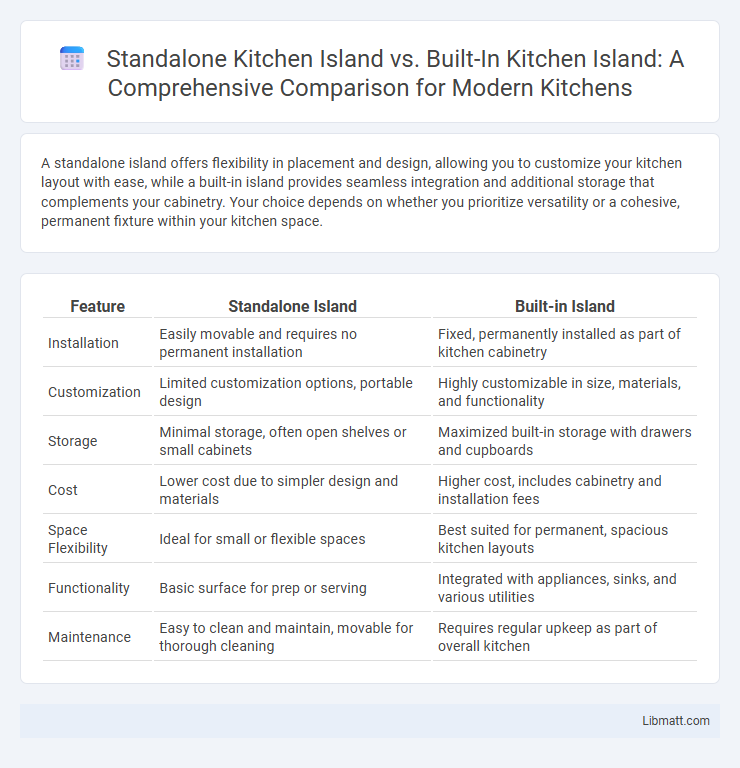A standalone island offers flexibility in placement and design, allowing you to customize your kitchen layout with ease, while a built-in island provides seamless integration and additional storage that complements your cabinetry. Your choice depends on whether you prioritize versatility or a cohesive, permanent fixture within your kitchen space.
Table of Comparison
| Feature | Standalone Island | Built-in Island |
|---|---|---|
| Installation | Easily movable and requires no permanent installation | Fixed, permanently installed as part of kitchen cabinetry |
| Customization | Limited customization options, portable design | Highly customizable in size, materials, and functionality |
| Storage | Minimal storage, often open shelves or small cabinets | Maximized built-in storage with drawers and cupboards |
| Cost | Lower cost due to simpler design and materials | Higher cost, includes cabinetry and installation fees |
| Space Flexibility | Ideal for small or flexible spaces | Best suited for permanent, spacious kitchen layouts |
| Functionality | Basic surface for prep or serving | Integrated with appliances, sinks, and various utilities |
| Maintenance | Easy to clean and maintain, movable for thorough cleaning | Requires regular upkeep as part of overall kitchen |
Introduction to Kitchen Islands
Kitchen islands serve as multifunctional workspaces that enhance both storage and workflow efficiency. Standalone islands offer flexible placement and often include additional cabinetry or seating, while built-in islands are integrated into the kitchen layout, maximizing space and connectivity with surrounding countertops. Understanding the differences between these types helps you choose the ideal island to optimize your kitchen's design and functionality.
What is a Standalone Island?
A standalone island in a kitchen is a freestanding unit that is not attached to any cabinetry or walls, offering maximum flexibility in design and placement. It often features storage space, seating, and countertop area, serving as a multifunctional workspace tailored to your cooking and entertaining needs. Unlike built-in islands, standalone islands can be moved or reconfigured, making them ideal for adaptable kitchen layouts.
What is a Built-in Island?
A built-in island is a permanent kitchen feature seamlessly integrated with existing cabinetry and countertops, offering a cohesive and customized workspace. Unlike standalone islands, built-in islands maximize space efficiency by incorporating built-in appliances, storage, and seating options. Your kitchen benefits from enhanced functionality and a streamlined design tailored to fit your layout perfectly.
Design Flexibility and Customization
Standalone kitchen islands offer greater design flexibility and customization by allowing homeowners to choose size, shape, and materials independently from existing cabinetry, making them ideal for unique layouts. Built-in islands are integrated into the kitchen cabinetry, providing a cohesive and streamlined look but less adaptability in terms of repositioning or redesign. Customization options for standalone islands include movable units with adjustable storage, while built-in islands often feature fixed configurations tailored to maximize space efficiency.
Space and Layout Considerations
A standalone island offers flexible placement options, ideal for large kitchens where ample space allows for movement around all sides, enhancing accessibility and workflow. Built-in islands often integrate with cabinetry and appliances, maximizing storage and functionality in compact layouts but requiring precise measurements to avoid crowding. Optimizing space with a standalone island suits open floor plans, while built-in islands streamline kitchen work zones in confined areas.
Storage and Functionality
Standalone kitchen islands offer flexible storage options with customizable cabinets and drawers, making them ideal for maximizing space in smaller kitchens. Built-in islands integrate seamlessly with existing cabinetry and typically provide more extensive storage solutions, such as pull-out shelves and hidden compartments, enhancing overall kitchen functionality. Both types improve workspace efficiency, but built-in islands often feature integrated appliances and seating areas for multitasking convenience.
Installation and Cost Factors
Standalone kitchen islands require minimal structural modification and can be installed quickly, making them a cost-effective option for budget-conscious homeowners. Built-in islands involve permanent installation, often requiring custom cabinetry, plumbing, and electrical work, which increases both labor and material expenses. The overall cost difference stems from the complexity of built-in island integration versus the portability and simplicity of standalone units.
Aesthetic Appeal and Style
Standalone islands offer versatile aesthetic appeal, serving as focal points with customizable shapes, colors, and materials that complement diverse kitchen styles. Built-in islands provide a seamless, integrated look that enhances the cohesive design of your kitchen, often matching cabinetry and countertops for a refined, unified appearance. Your choice depends on whether you prioritize bold, statement-making style or harmonious, understated elegance.
Pros and Cons Comparison
Standalone kitchen islands offer flexibility in placement and design, making them ideal for various kitchen layouts and easy remodeling. Built-in islands provide integrated storage and countertop space, enhancing kitchen workflow and stability but require permanent installation. You should weigh the adaptability of standalone islands against the functional benefits and permanence of built-in options to determine the best fit for your cooking space.
Choosing the Right Island for Your Kitchen
Standalone kitchen islands offer flexibility and mobility, making them ideal for smaller spaces or renters who may want to rearrange their layout. Built-in islands provide increased storage, countertop space, and seamless integration with cabinetry, enhancing functionality and kitchen flow. Your choice depends on your space, cooking habits, and desire for permanence versus adaptability.
Standalone island vs built-in island (kitchen) Infographic

 libmatt.com
libmatt.com